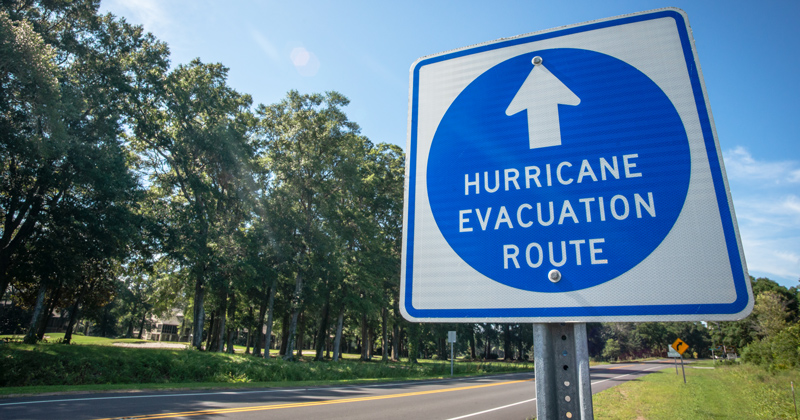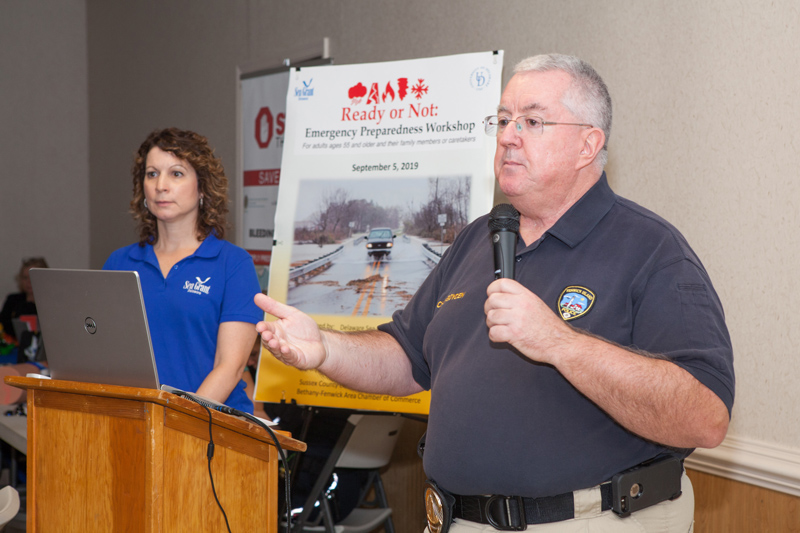


Emergency preparedness
Photos by Judy Rolfe and iStock October 23, 2019
UD and Delaware Sea Grant teams share tips with Sussex residents
With Hurricane Dorian devastating the Bahamas, emergency planning and being prepared for a severe weather event was on everyone’s mind at a “Ready or Not: Emergency Preparedness Workshop” held at a packed Roxana Fire Hall on Thursday, Sept. 5.
The workshop was geared towards adults over the age of 55, their families and caretakers to help older adults prepare for emergencies by addressing their unique needs and concerns.
The event was hosted by the towns of South Bethany, Fenwick Island, and Selbyville, together with Delaware Sea Grant (DESG) and the Institute for Public Administration (IPA) at the University of Delaware. It was led by Danielle Swallow, coastal hazard specialist for DESG, and Julia O’Hanlon, a policy scientist with IPA.
Delaware Hazards
Swallow said that the top three hazards impacting Delaware communities are coastal flooding, nor’easters and hurricanes. The same natural resources that draw people to coastal communities, such as the opportunity to live by beaches and bays, are the same resources that make those communities especially vulnerable.

Swallow explained that Delaware is facing double trouble with intensifying storms and a rate of sea level rise that is twice the global average.
“Sea level rise basically increases the average height of our high tides and our low tides,” Swallow said. “If you live near a marsh area, think about that marsh as now storing more water than it previously did. So when rain comes in, when a storm surge comes in, that wetland area and marsh area is slower to drain out.”
While beachfront properties have dunes to protect them, the inland properties face more vulnerability as they are closer to the bays, tributaries and marsh areas where no such protective systems are available.
Swallow added that Delawareans are increasing their exposure to impacts from these storms because they’re building in some of the more highly vulnerable areas of coastal Sussex. In addition to putting more houses in the path of hazards, such development is taking away land that can absorb water.
Add to that an aging Sussex County population, which will have 30 percent of the county population over the age of 65 by the year 2030, and there is a dire need for emergency preparedness in the event of large storms.
“Our risks and vulnerabilities are increasing, but the good news is that we can take steps to help mitigate some of that,” said Swallow. “You’re here today because you’ve worked hard in your life to retire and to enjoy the lifestyle that this area affords you, and it’s important to protect that life that you’ve built. Taking the steps now to prepare can help you do that.”
Participants received training on evacuation routes and shelters, emergency supply kits, and managing health and mobility issues during the workshop and were given the opportunity to fill out an emergency health communications card. They could also engage with emergency responders, healthcare providers, agencies, and businesses who exhibited information on the services available to older adults before, during, or after emergency events.
O’Hanlon spoke about aging in place and said that all of those present at the workshop had already taken a vital step towards successfully aging in place by getting more information about the resources available to them in the case of inclement weather.
“Sussex County is continuing to age. It’s a popular place to retire,” said O’Hanlon, who recently developed a Planning for Age Friendly Communities report for IPA. “Obviously, we have wonderful coastal communities, it’s beautiful. But we want to maintain that lifestyle and having the resources and understanding and being educated about what resources are available is part of successfully aging in place.”
UD students from O’Hanlon’s institute were on hand to help participants register for Smart 9-1-1, a service that provides first responders with personal information such as medications individuals take and their emergency contact numbers so the emergency services can better serve them in a crisis.
William Boyden, chief of the Fenwick Island Police Department, talked to participants about the importance of being prepared and having a plan in place in case of an emergency.
Some of the tips highlighted by Boyden included:
Plan where you will go and the route to get there
Have a hotel designated if you can’t go home
Pack an overnight bag with a change of clothes, some toiletries and extra medications
Have some food and water in case you get stuck in traffic on the highway
Make sure your car is always full of gas
He said that in the case of emergencies, most towns have alert systems on their websites. Swallow added that it’s good to sign up for multiple alert systems, such as a local emergency alert system and also a state-wide emergency alert system.
Boyden pointed out that while everyone usually thinks of hurricanes as the biggest threat along the coast, Delaware is particularly vulnerable to Nor’easters, storms that have hurricane force winds and bring lots of rain over a prolonged period of time.
He also spoke on how to exit coastal communities safely and effectively and warned about the perils of not heeding warnings given by state and government agencies.
“The biggest problem we have here with evacuations is that people just don’t heed the warning,” said Boyden. “When we give a warning, in my past experience, people just don’t listen. People usually say ‘Well, we’ve never had this happen so it’s not going to happen’ and I always say, ‘You’ve probably never had a house fire, but you have a fire department and you usually have a fire extinguisher.’ ”
Contact Us
Have a UDaily story idea?
Contact us at ocm@udel.edu
Members of the press
Contact us at 302-831-NEWS or visit the Media Relations website

